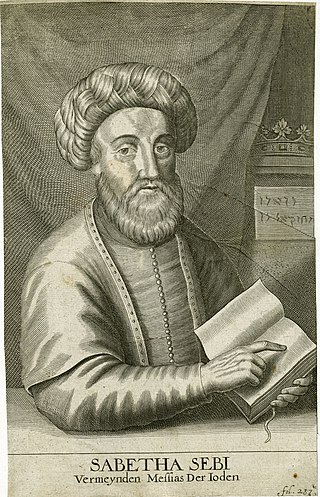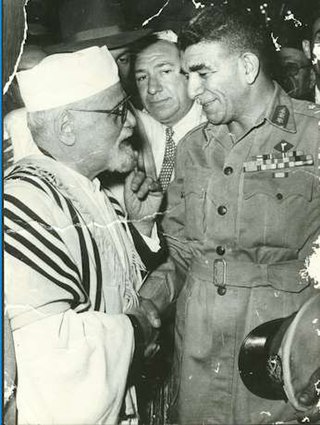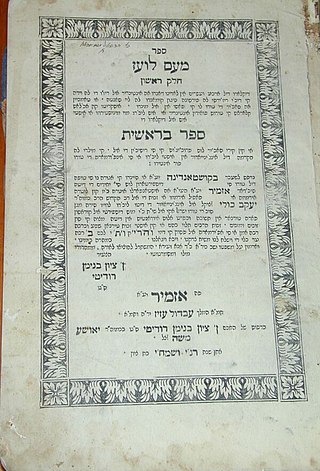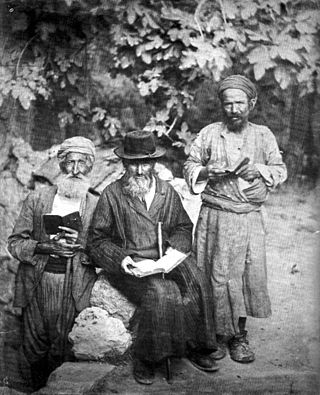Related Research Articles

The Sabbateans were a variety of Jewish followers, disciples, and believers in Sabbatai Zevi (1626–1676), a Sephardic Jewish rabbi and Kabbalist who was proclaimed to be the Jewish Messiah in 1666 by Nathan of Gaza.

Jacob ben Asher, also known as Ba'al ha-Turim as well as Rabbi Yaakov ben Raash, was an influential Medieval rabbinic authority. He is often referred to as the Ba'al ha-Turim, after his main work in halakha, the Arba'ah Turim.
Israel ben Moses Najara was a prolific Jewish liturgical poet, preacher, Biblical commentator, kabbalist, and rabbi of Gaza.
Schisms among the Jews are cultural as well as religious. They have happened as a product of historical accident, geography, and theology.

Chaim (Haim) Nahum Effendi (1872–1960) was a Jewish scholar, jurist, and linguist of the early 20th century.

The Spanish Benveniste family is an old, noble, wealthy, and scholarly Jewish family of Narbonne, France and northern Spain established in the 11th century. The family was present in the 11th to the 15th centuries in Hachmei Provence, France, Barcelona, Aragon and Castile.

The history of the Jews in Turkey covers the 2400 years that Jews have lived in what is now Turkey.
Minhag is an accepted tradition or group of traditions in Judaism. A related concept, Nusach (נוסח), refers to the traditional order and form of the prayers.

Me'am Lo'ez, initiated by Rabbi Yaakov Culi in 1730, is a widely studied commentary on the Tanakh written in Judaeo-Spanish. It is perhaps the best known publication in that language.
Alexander SuslinHaKohen was a prominent 14th century rabbinic authority born in Erfurt, Germany, and one of the most important Talmudists of his time. He was rabbi first in Cologne and Worms, and then moved to Frankfort-on-the-Main. He authored Sefer HaAguddah, a halakhic work which was highly regarded by later rabbinic authorities. He was killed in the Erfurt massacre of 1349 during the Black Death era massacres of hundreds of Jewish communities throughout Europe.
The history of the Jews and Judaism in the Land of Israel has its origins in the 2nd millennium BCE, when Israelites emerged as an outgrowth of southern Canaanites, During biblical times, a postulated United Kingdom of Israel existed before splitting into two Israelite kingdoms occupying the highland zone: the Kingdom of Israel (Samaria) in the north, and the Kingdom of Judah in the south. The Kingdom of Israel was conquered by the Neo-Assyrian Empire, and the Kingdom of Judah by the Neo-Babylonian Empire. Initially exiled to Babylon, upon the defeat of the Neo-Babylonian Empire by the Achaemenid Empire under Cyrus the Great, many of the Jewish exiles returned to Jerusalem, building the Second Temple.
Judah ben Samuel Rosanes (1657–1727) was Rabbi of Constantinople and son-in-law of Abraham Rosanes I. His teachers in Talmud and rabbinics were Samuel HaLevi and Joseph di Trani the Younger. On account of his knowledge of Arabic and Turkish he was appointed by the government as chief rabbi of the Ottoman empire. He died at an advanced age in Constantinople on April 13, 1727.

Haim Palachi was a Jewish-Turkish chief rabbi of Smyrna (İzmir) and author in Ladino and Hebrew. His titles included Hakham Bashi and Gaon. He was the father of grand rabbis Abraham Palacci and Isaac Palacci and rabbi Joseph Palacci. He was a member of the Pallache family.
The Tzuf Dvash Synagogue is a Sephardic synagogue which was founded in 1860 under Ottoman Empire rule in the Jewish Quarter of the Old City of Jerusalem. Today it is located at 15 Plugat ha-Kotel Street.

Yaakov Meir CBE (1856–1939), was an Orthodox rabbi, and the first Sephardic Chief Rabbi appointed under the British Mandate of Palestine. A Talmudic scholar, fluent in Hebrew as well as five other languages, he enjoyed a reputation as one of Jerusalem's most respected rabbis.

The history of the Jews of Thessaloniki reaches back two thousand years. The city of Thessaloniki housed a major Jewish community, mostly Eastern Sephardim, until the middle of the Second World War. Sephardic Jews immigrated to the city following the expulsion of Jews from Spain by Catholic rulers under the Alhambra Decree of 1492. It is the only known example of a city of this size in the Jewish diaspora that retained a Jewish majority for centuries. This community influenced the Sephardic world both culturally and economically, and the city was nicknamed la madre de Israel.

The Old Yishuv were the Jewish communities of the region of Palestine during the Ottoman period, up to the onset of Zionist aliyah and the consolidation of the New Yishuv by the end of World War I. In the late 19th century, the Old Yishuv comprised 0.3% of the world's Jews, representing 2–5% of the population of the Palestine region.

By the time the Ottoman Empire rose to power in the 14th and 15th centuries, there had been Jewish communities established throughout the region. The Ottoman Empire lasted from the early 14th century until the end of World War I and covered parts of Southeastern Europe, Anatolia, and much of the Middle East. The experience of Jews in the Ottoman Empire is particularly significant because the region "provided a principal place of refuge for Jews driven out of Western Europe by massacres and persecution."
Eastern Sephardim are a distinctive sub-group of Sephardic Jews mostly descended from Jewish families which were exiled from Iberia in the 15th century, following the Alhambra Decree of 1492 in Spain and a similar decree in Portugal five years later. This branch of descendants of Iberian Jews settled across the Eastern Mediterranean.

"Pallache" – also de Palacio(s), Palache, Palaçi, Palachi, Palacci, Palaggi, al-Fallashi, and many other variations (documented below) – is the surname of a prominent, Ladino-speaking, Sephardic Jewish family from the Iberian Peninsula, who spread mostly through the Mediterranean after the Alhambra Decree of March 31, 1492, and related events.
References
- 1 2 Naar, Devin E. (2016). Jewish Salonica: Between the Ottoman Empire and Modern Greece. Stanford, California: Stanford University Press. p. 205.
- ↑ The title was later changed to Korot ha-Yehudim be-Turkiyah ve-'Arzot ha-Kedem. The French title was Histoire des Israelites de Turquie (Turquie, Hongrie, Serbie, Bulgarie, Bosnie, Albanie et Grèce) Et de L`Orient (Syrie, Palestine, Egypte etc.)
- ↑ Behar, Moshe; Benite, Zvi Ben-Dor (2013). Modern Middle Eastern Jewish Thought: Writings on Identity, Politics and Culture. Waltham, Massachusetts: Brandeis University Press. pp. 4–5.
- ↑ Gerber, Jane (1995). Sephardic Studies in the University. United States: Fairleigh Dickinson University Press. p. 73.
- ↑ Little is known about the Dolya massacre. According to Ben-Jacob, Salonican Jewish merchants returning home from an annual fair in present day Macedonia were massacred by brigands. A fast day was designated by the rabbis to be observed by all Salonican Jews across generations at commemoration ceremonies at the Talmud Tora. When the Talmud Tora was destroyed in a fire in 1620 the community memory of the massacre faded,
- ↑ Herzog, Christoph; Wittmann, Richard (2019). Istanbul - Kushta - Constantinople:Narratives of Identity in the Ottoman Capital 1830-1930. United Kingdom: Routledge.